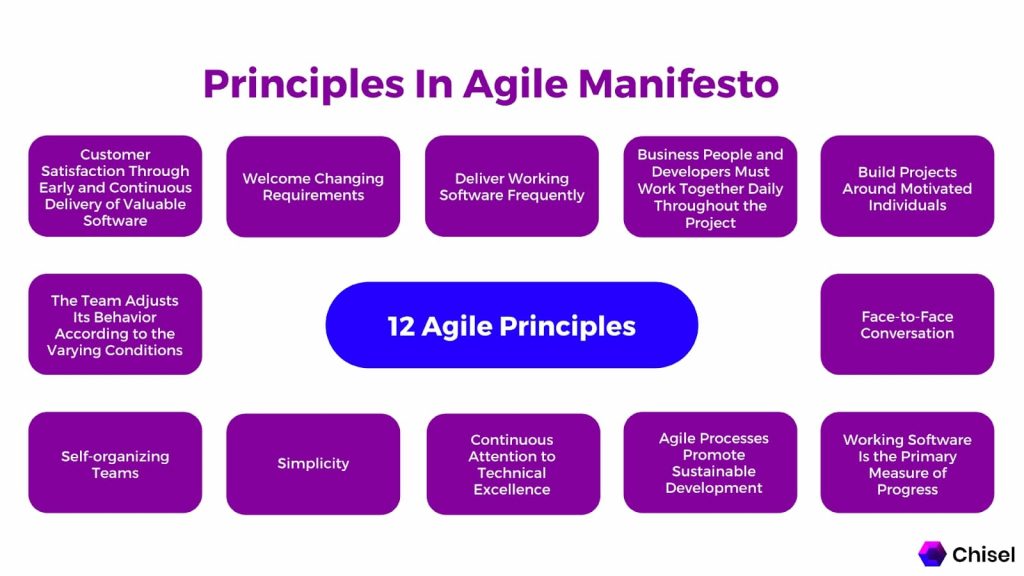What is the Summary of the Agile Manifesto?
In the fast-paced world of software development, efficiency and adaptability are paramount. Enter the Agile Manifesto, a guiding light for teams looking to navigate the ever-changing landscape of project management. In this article, we will explore the Agile Manifesto in depth, uncovering its core principles, its significance, and its practical application in various industries. Let’s embark on a journey to understand “What is the summary of the Agile Manifesto?”
The Agile Manifesto Unveiled
Agile Manifesto – The Foundation
The Agile Manifesto serves as the cornerstone of agile methodologies. It emphasizes four core values:
- Individuals and interactions over processes and tools.
- Working software over comprehensive documentation.
- Customer collaboration over contract negotiation.
- Responding to change over following a plan.
These values provide a compass for teams, steering them toward more effective and customer-centric development processes.
Principles of the Agile Manifesto
To further expand on these values, the Agile Manifesto presents twelve guiding principles:
- Customer satisfaction through continuous delivery: Prioritize delivering valuable software frequently.
- Welcome changing requirements: Embrace change as a competitive advantage.
- Deliver working software frequently: Aim for shorter development cycles and frequent releases.
- Collaboration between stakeholders and developers: Foster open communication and teamwork.
- Build projects around motivated individuals: Trust and empower your team members.
- Face-to-face communication: Opt for direct interactions whenever possible.
- Working software as the primary measure of progress: Tangible results should drive assessment.
- Sustainable development pace: Maintain a pace that the team can sustain indefinitely.
- Technical excellence and good design: Strive for high-quality work.
- Simplicity: Focus on what is essential.
- Self-organizing teams: Empower teams to make decisions.
- Reflection and adaptation: Regularly introspect and adjust your processes.
Benefits of Embracing Agile
1. Enhanced Flexibility
Agile methods allow teams to adapt swiftly to changing requirements and market conditions. This flexibility can be a game-changer, especially in industries characterized by rapid innovation.
2. Improved Product Quality
The Agile Manifesto promotes a focus on delivering working software, which often results in higher product quality as defects are detected and addressed earlier in the development cycle.
3. Increased Customer Satisfaction
By involving customers throughout the development process, Agile methodologies ensure that the end product aligns with customer needs and expectations, leading to higher satisfaction rates.
4. Efficient Resource Utilization
Agile principles encourage teams to concentrate on essential tasks, reducing wastage and optimizing resource allocation.
5. Faster Time-to-Market
Shorter development cycles mean that products reach the market faster, allowing businesses to capitalize on opportunities promptly.
FAQs
Is Agile Only for Software Development?
No, Agile principles are applicable to various industries, including marketing, manufacturing, and healthcare. Any project that requires adaptability and customer-centricity can benefit from Agile.
What Are Some Popular Agile Frameworks?
Scrum, Kanban, and Lean are some of the well-known Agile frameworks, each with its unique approach to Agile implementation.
How Do I Get Started with Agile?
Begin by educating your team about Agile principles and selecting an Agile framework that suits your organization’s needs. Consider seeking guidance from Agile experts.
Can Agile Work for Large-Scale Projects?
Yes, Agile can be scaled up for larger projects. Methods like SAFe (Scaled Agile Framework) are designed to address the complexities of large-scale Agile implementations.
What Are the Common Challenges in Agile Adoption?
Challenges may include resistance to change, lack of proper training, and difficulties in maintaining Agile principles as organizations grow. These challenges can be overcome with dedication and support.
Is Agile a Replacement for Traditional Project Management?
No, Agile is not a replacement but a complementary approach. Some projects may still benefit from traditional project management methodologies.
Conclusion
The Agile Manifesto is a guiding light for modern project management, emphasizing values, principles, and practices that promote adaptability, collaboration, and customer satisfaction. Whether you’re a software developer, a project manager, or an executive, understanding “What is the summary of the Agile Manifesto?” is essential in today’s dynamic business landscape. Embracing Agile can lead to enhanced flexibility, higher product quality, and increased customer satisfaction. So, take the plunge into the world of Agile and experience its transformative power firsthand.
READ MORE: How to Get Values of JSON Array Elements in PHP





